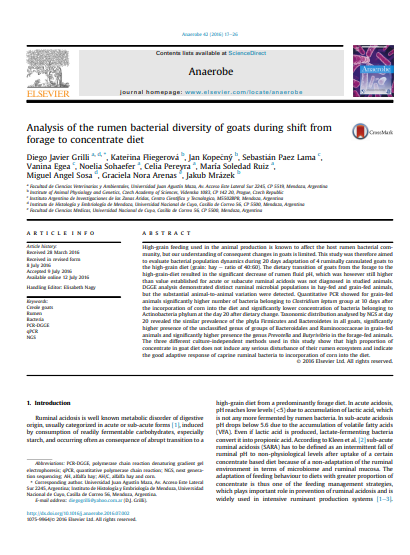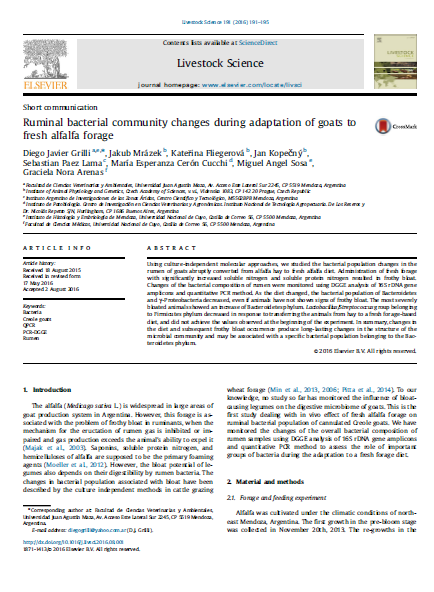Browsing by Author "Kopečný, Jan"
Now showing items 1-3 of 3
-
Analysis of the rumen bacterial diversity of goats during shift from forage to concentrate diet.
Grilli, Diego Javier; Fliegerová, Kateřina; Kopečný, Jan; Paez Lama, Sebastián; Egea, Vanina; Sohaefer, Noelia; Pereyra, Celia; Ruiz, María Soledad; Sosa, Miguel Angel; Arenas, Graciela Nora; Mrázek, Jakub (Comité editor Journal Anaerobe, 2016-07-12)High-grain feeding used in the animal production is known to affect the host rumen bacterial community, but our understanding of consequent changes in goats is limited. This study was therefore aimed to evaluate bacterial population dynamics during 20 days adaptation of 4 ruminally cannulated goats to the high-grain diet (grain: hay e ratio of 40:60). The dietary transition of goats from the forage to the high-grain-diet resulted in the significant decrease of rumen fluid pH, which was however still higher than value established for acute or subacute ruminal acidosis was not diagnosed in studied ... -
Identificación de genes xilanasas a partir de bacterias ruminales aisladas de cabras criollas en pastoreo
Grilli, Diego; Kopečný, Jan; Mrázek, Jakub; Cerón, María; Cravero, S; Schnittger, L; Arenas, Nora (Editorial Umaza, 2012-10)En la región de Lavalle (Mendoza), las cabras componen su dieta con una alta proporción de especies arbustivas, las que constituyen una importante oferta de fibra vegetal (celulosa y hemicelulosa, principalmente). La gran eficiencia en la utilización de dicha fibra por estas cabras puede deberse, entre otros factores, a las características de las bacterias ruminales fibrolíticas (celulolíticas y hemicelulolíticas). Por lo tanto el estudio de estas bacterias y sus enzimas fibrolíticas adquieren gran importancia en los sistemas de producción caprina en nuestro país. La diversidad y organización ... -
Ruminal bacterial community changes during adaptation of goats to fresh alfalfa forage.
Grilli, Diego Javier; Mrázek, Jakub; Fliegerová, Kateřina; Kopečný, Jan; Paez Lama, Sebastian; Cerón Cucchi, María Esperanza; Sosa, Miguel Angel; Arenas, Graciela Nora (Editorial Livestock Science, 2016-08-02)Using culture-independent molecular approaches, we studied the bacterial population changes in the rumen of goats abruptly converted from alfalfa hay to fresh alfalfa diet. Administration of fresh forage with significantly increased soluble nitrogen and soluble protein nitrogen resulted in frothy bloat. Changes of the bacterial composition of rumen were monitored using DGGE analysis of 16S rDNA gene amplicons and quantitative PCR method. As the diet changed, the bacterial population of Bacteroidetes and γ-Proteobacteria decreased, even if animals have not shown signs of frothy bloat. The most ...












